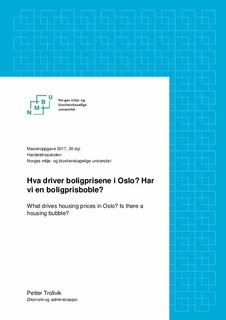| dc.contributor.advisor | Kristiansen, Glenn Roger | |
| dc.contributor.advisor | Sommervoll, Dag Einar | |
| dc.contributor.author | Trollvik, Petter | |
| dc.coverage.spatial | Norway, Oslo | nb_NO |
| dc.date.accessioned | 2017-11-09T09:34:35Z | |
| dc.date.available | 2017-11-09T09:34:35Z | |
| dc.date.issued | 2017 | |
| dc.identifier.uri | http://hdl.handle.net/11250/2465132 | |
| dc.description.abstract | I denne oppgaven undersøker vi hva som driver boligprisene i Oslo og om vi er inne i en boligboble. To problemstillinger drøftes. «Hva driver boligprisene i Oslo?», hvor vi undersøker boligmarkedet, teori rundt boligprisdannelsen og redegjør for sentrale drivere. Fem hypoteser testes ved bruk av regresjon i SPSS. Vi legger til grunn årlige data fra 1992-2016 i regresjonsanalysen. Fra regresjonsanalysen finner vi at det kun er «disponibel inntekt» som har en signifikant effekt på boligprisen.
Problemstillingen «Har vi en boligprisboble i Oslo?» undersøker vi ved å se på leiepris og anleggskostnader opp mot boligprisen, for deretter å regne ut rater for Price to Rent og Tobins Q. Datagrunnlaget for Price to Rent går fra 1980 til 2016, Tobins Q går fra 1982 til 2016. Ratene er regnet ut ved bruk av Excel. Fra ratene finner vi at boligprisene i Oslo avviker positivt fra det som kan forklares fundamentalt. Det tyder på at boligprisene fra 2013 til og med 2016 er overpriset og overvurdert, uten at vi kan konkludere med hvor mye. Vi finner at boligmarkedet i Oslo pr. januar 2017 har bobletendenser. | nb_NO |
| dc.description.abstract | This assignment examines what drives the pricing of houses in Oslo and whether there is a housing bubble. The assignment will examine two main questions. Firstly, «What drives the housing prices in Oslo?», where we study the housing market, look at theories on the forming of housing prices and explain its central drivers. Five hypotheses are tested using regression in SPSS, based on annual data from 1992 to 2016. The regression analysis finds that only «disposable income» has a significant effect on housing prices.
«Is there a housing price bubble in Oslo?» is examined by looking at the rental price and construction costs, relating them to the housing prices, and calculating ratios for Price to Rent and Tobin’s Q. The data for Price to Rent is from 1980 to 2016, the data for Tobin’s Q is from 1982 to 2016. The ratios are calculated using Excel. From the ratios, we find that housing prices in Oslo deviates positively from what can be explained fundamentally. This suggests that housing prices from 2013 even 2016 are overpriced and overestimated, without being able to quantify how much. We find that there are indications of a housing bubble in Oslo per January 2017. | nb_NO |
| dc.language.iso | nob | nb_NO |
| dc.publisher | Norwegian University of Life Sciences, Ås | nb_NO |
| dc.rights | Attribution-NonCommercial-NoDerivatives 4.0 Internasjonal | * |
| dc.rights.uri | http://creativecommons.org/licenses/by-nc-nd/4.0/deed.no | * |
| dc.subject | Boligpriser | nb_NO |
| dc.subject | Tobins Q | nb_NO |
| dc.subject | Tobin's Q | nb_NO |
| dc.subject | P/R | nb_NO |
| dc.subject | Bobleteori | nb_NO |
| dc.subject | Boligteori | nb_NO |
| dc.title | Hva driver boligprisene i Oslo : har vi en boligprisboble? | nb_NO |
| dc.title.alternative | What drives housing prices in Oslo : is there a housing bubble? | nb_NO |
| dc.type | Master thesis | nb_NO |
| dc.description.version | submittedVersion | nb_NO |
| dc.subject.nsi | VDP::Samfunnsvitenskap: 200::Økonomi: 210 | nb_NO |
| dc.source.pagenumber | 70 | nb_NO |
| dc.description.localcode | M-ØA | nb_NO |

